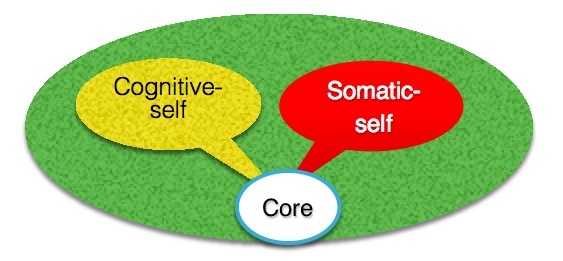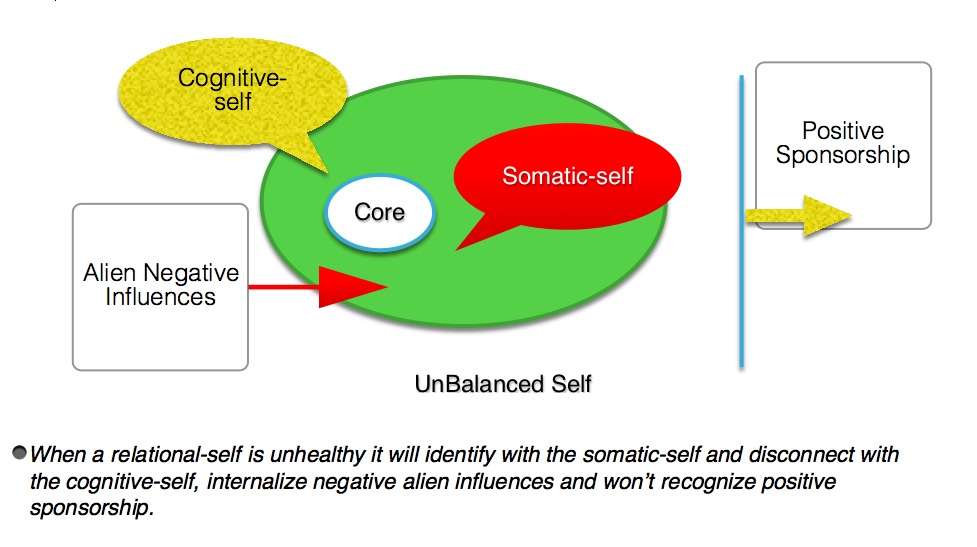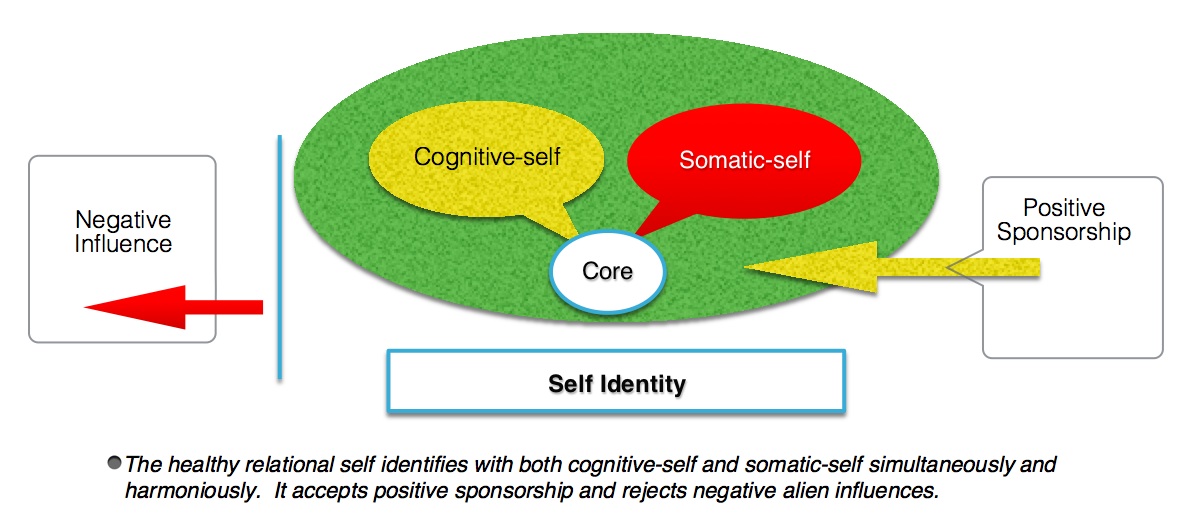What is Self-Relations Psychotherapy?
By Dr. Anthony Gaudioso LMHC, PhD, Licensed Mental Health Counselor
Self-relations therapy was originally developed by Stephen Gilligan as an expansion of his studies as Milton Ericsson’s apprentice. The theory has evolved from its roots in Hypnotherapy, Jungian theory, and ancient Buddhist teachings into a modern approach that honors the dynamics of individual and collective consciousness. A key premise of Self-relations therapy is that psychological symptoms are the body and mind’s way of trying to ‘awaken’ the soul. In other words, something like depression may be viewed not simply as a biologically based condition, but as a nudge to reexamine deeper parts of one’s life.
The underpinnings of Self-Relations Therapy
Two Selfs
In self-relations theory there is always a dynamic at play. Every individual is composed of two selfs; the cognitive-self (thinking) and the somatic-self (feeling). A dialogue between the two selfs occurs as positive and negative influences are processed. Through the relationship between the cognitive-self and somatic-self these influences are either internalized or externalized, thus helping or harming the identity and functioning of the individual.

Attention to the Center
Everyone has a central ‘core spot’ they experience themselves from. It’s the spot you gain the best perspective from to make choices that involve the relationship between your feelings, beliefs, intellect and situations. If you imagined being out in a large crop field and had to see every part of it so you could make choices about how to plant a garden; this would be the place where you would have the clearest viewpoint from. You may lose touch with your center and you may operate and view things from a perspective that is off of your center. Your attention can move from your center but your center doesn’t move.
Balance is one of the goals of self-relations. Dysfunction is caused by holding attention too tight (which causes fear and anxiety) or too loose (which creates indifference and addiction). Holding attention ‘just right’ brings you back to your center and leads to balance and harmony within yourself or in relation to others.
The therapeutic relationship
In self-relations a healthy collaboration between therapist and client is imperative to the process. This is where the artistry of a self-relations therapist is displayed through the use of language, inquiry building, guiding, attuning, supporting and challenging. A foundational premise of self-relations psychotherapy is that the process is fluid. The therapist works from a “soft focus,” whereby principles and guidelines are emphasized over rigid technique or structures. Although there are goals and direction, self-relations psychotherapy is based on the basic premises and practices that facilitate access and reconnection to a healthy relationship with one’s self.
Individuality and Archetypical
A core premise of self-relations work is that individuals vary in multiple facets of personality and those differences are embraced and empowered through the therapeutic process. Although every human being is unique and has their own central core spot, we also have universal or collective ways of relating to one another. Many relational undercurrents represent the countless history of similar dynamics. Thus a conflict between siblings is unique to those particular siblings but also universal in that there exists an archetype of “sibling rivalry” common through the history of human siblings, siblings.
Relationship with others: Positive Sponsorship and Alien Influence
Understanding and coping with relational differences is another important task of self-relations. The impact of positive and negative interactions between you and others shape identity. They can either influence a positive connection within yourself or they can have a negative impact and can disrupt your relationship with yourself and others.

Self-relations is built on the idea that there are skills that can heal your relationship with yourself and others. By identifying and applying skills to distinguish positive influences and externalize negative (or “alien’) influences, the cognitive-self is empowered and the somatic self can be accessed and healed from trauma or neglect. These fundamental skills are called sponsorship.
For example, a parent may ‘sponsor’ a child by encouraging them to face fears with courage and confidence…without this sponsorship, a child may avoid challenges and develop anxiety as they mature. An alien influence that could lead to a child developing self esteem issues could come from an influential figure like a teacher who disempowers the child by telling them that they aren’t capable of managing a task.
The process of Self-relations psychotherapy
The Self-relations process begins as the therapist works with the client to build a therapeutic alliance and open an inquiry into the presenting problem/s.
Using therapeutic dialogue the therapist guides the client in accessing and revealing the disconnection between the cognitive-self and the somatic-self, thus defining the mechanisms of the neglected-self and any derogatory inner dialogues, beliefs and paradigms that need to be healed.
The discussions continue exploring the inner and outer relationship dynamics of the client’s, working to align attention and perspective back to the client’s center. There is a natural flow between guidance and collaboration, focusing on the development of skills to cope with relationship to self and others.
The self-relations approach aims to build the capabilities of the cognitive-self while healing the somatic-self from the impact of neglect and internalized negative influences and experiences.
For example…if as a child you had experienced being teased about your performance in a school play, some of those interactions could be internalized and your somatic self could then identify as anxious. Now as an adult you may be fearful of presenting a proposal to work colleagues because your somatic/feeling-self believes you are not capable. In therapy, the self-relations therapist would help you identify the differences in how you feel and how you think. The therapist recruits your cognitive/thinking-self in promoting the idea that you are capable in your professional skills to take on the challenge.
The therapist helps the client with positive sponsorship by helping the client dispute the internalized feelings of the past experience and encourage the sense that they can manage the challenge.
As mentioned previously, throughout the process of Self-Relations Therapy, positive sponsorship and “alien” negative influences are distinguished from one another. Positive sponsorship is increased; negative alien influences are externalized from the clients identity; and the neglected parts of self are given attention, affirmation, support and acceptance. From the earlier example related to internalizing the negative experience of teasing, the therapist may then help point out how many times they were praised by coworkers for their work on tasks related to the project they are going to present on.
Through this process the client begins to experience a more harmonious self relationship between cognitive and emotional processes. This eventually translates to healthier interactions with others as well. Maintaining the skills of a balanced inner dialogue, the client can now choose what they allow in or keep out of their self identity.
 About this Contributor: Anthony Gaudioso LMHC, PhD is a practicing Licensed Mental Health Counselor with offices in New York City and Kingston, NY. Dr Gaudioso has been in private practice in NYC since 2004 and had a practice in Miami for 10 years prior to that. He completed a Masters of Science in Mental Health Counseling and then a PhD in Counseling at Barry University. He is also a certified Clinical Hypnotherapist trained in the Ericksonian model to provide hypnosis and Neurolinguistic programing to his clients and has an integrated theoretical framework that includes self-relations, cognitive behavioral, experiential, person-centered, psychodynamic and mindfulness approaches. He has an extensive background in providing individual, couples, family and group therapy and has varied experience helping clients coping with relationship issues, addictions, body issues, anxiety, depression, sex and sexuality. He has also provided clinical supervision to dozens of therapist throughout his career and is currently writing a self help book as well as maintaining a therapy blog on his practice website.
About this Contributor: Anthony Gaudioso LMHC, PhD is a practicing Licensed Mental Health Counselor with offices in New York City and Kingston, NY. Dr Gaudioso has been in private practice in NYC since 2004 and had a practice in Miami for 10 years prior to that. He completed a Masters of Science in Mental Health Counseling and then a PhD in Counseling at Barry University. He is also a certified Clinical Hypnotherapist trained in the Ericksonian model to provide hypnosis and Neurolinguistic programing to his clients and has an integrated theoretical framework that includes self-relations, cognitive behavioral, experiential, person-centered, psychodynamic and mindfulness approaches. He has an extensive background in providing individual, couples, family and group therapy and has varied experience helping clients coping with relationship issues, addictions, body issues, anxiety, depression, sex and sexuality. He has also provided clinical supervision to dozens of therapist throughout his career and is currently writing a self help book as well as maintaining a therapy blog on his practice website.
For more information about Anthony’s work, please visit: www.ny-counselors.com.

